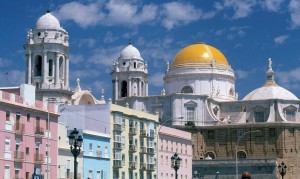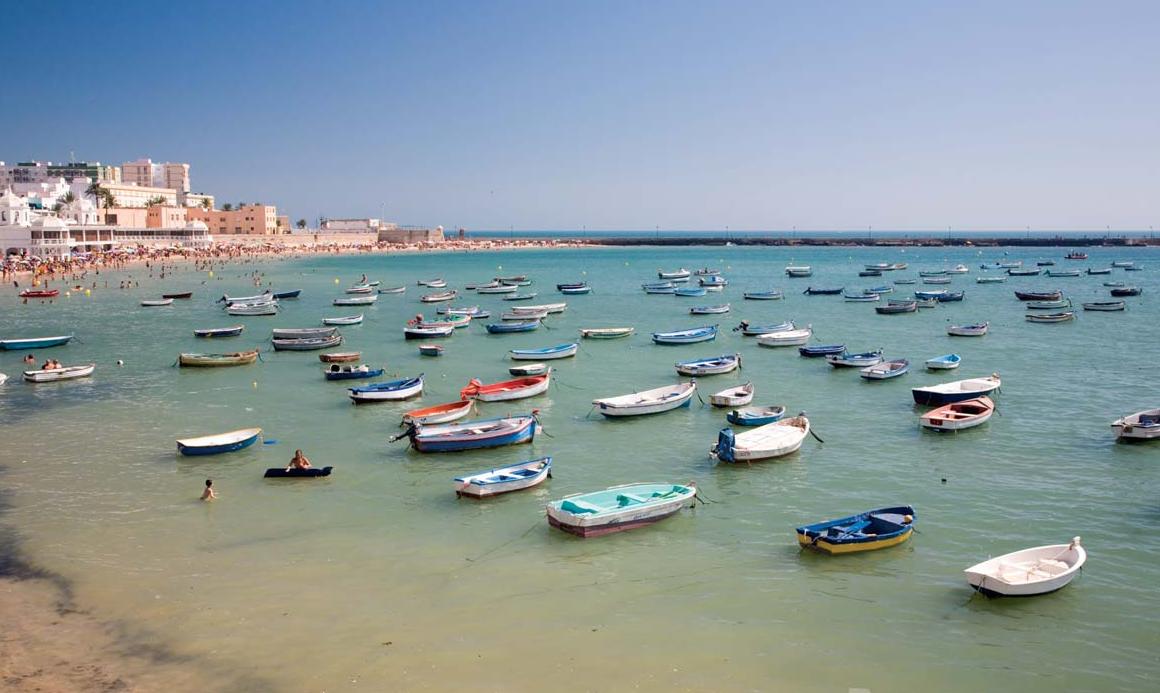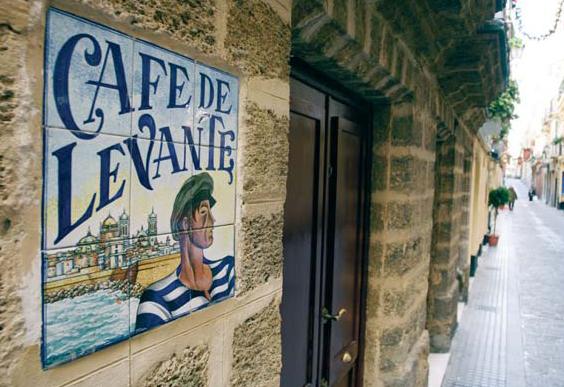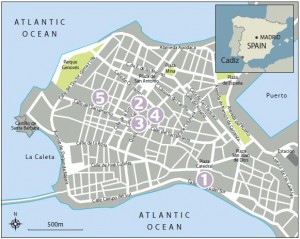 An enduring question makes its presence felt as i make my way north from Gibraltar along Spain’s Atlantic coast, the legendary miradors of Cadiz tempting me ever onwards. If a soul is something an ancient city actually possesses, where might I find it? Will it be among the throngs crowding Cadiz’s ancient lanes and modern avenues, strolling in the shade of exotic trees, or gossiping in the markets, cafés and inns? Will it be discerned in the darkness of night, while listening through an open window to the ocean’s surf piling onto the deserted beach? Does it derive from geography and the culture and history imprinted by the traders, merchants and artists who have settled here ever since the Phoenicians dominated Mediterranean commerce? Built on an island at Europe’s extremity and surrounded by the Atlantic, will Cadiz remain simply a physical entity, viewed from a hill or a tower? For a sense of place, I climbed to the top of Tavira Tower, the tallest mirador among the 160-odd scattered throughout the city.
An enduring question makes its presence felt as i make my way north from Gibraltar along Spain’s Atlantic coast, the legendary miradors of Cadiz tempting me ever onwards. If a soul is something an ancient city actually possesses, where might I find it? Will it be among the throngs crowding Cadiz’s ancient lanes and modern avenues, strolling in the shade of exotic trees, or gossiping in the markets, cafés and inns? Will it be discerned in the darkness of night, while listening through an open window to the ocean’s surf piling onto the deserted beach? Does it derive from geography and the culture and history imprinted by the traders, merchants and artists who have settled here ever since the Phoenicians dominated Mediterranean commerce? Built on an island at Europe’s extremity and surrounded by the Atlantic, will Cadiz remain simply a physical entity, viewed from a hill or a tower? For a sense of place, I climbed to the top of Tavira Tower, the tallest mirador among the 160-odd scattered throughout the city.
From here one’s attention is drawn south, across the city’s peerless beaches and stretching to an isolated spit of shoreline going by the name of Cape Trafalgar. As I looked out, I remembered reading that it was from here that spotters scoured the skyline for signs of pirate ships and, more famously, evidence of Britain’s Royal Navy. The waves breaking on the rocky shoals are the same that for centuries have proven disastrous for mariners. Turning to the north I imagined Bucentaure, the stricken flagship of the French Admiral Pierre Villeneuve, as it was ripped apart on these rocks following the celebrated naval battle here. The main navigable channel sweeps around the salt pans of the marshy Isla de Leon, home to some of the tastiest fish ever to reach a restaurant table, to the dockyards of La Carraca, where for centuries Spain’s great wooden sailing ships were built and repaired. On a sunny day – and most days here are sunny – the streets of the Old Town radiate in deep shadow from around the base of Tavera Tower. Being too narrow to bear heavy traffic, they have changed little over the centuries. The exception is the Alameda, a fine avenue overlooking the entrance to the bay. Here the elegant ladies and gentlemen of the town seek the shade of the trees growing handsomely along its length. At the western end, in baroque splendour, stands the Iglesia del Carmen. This is the church where the officers and men of Napoleon’s Combined Fleet gathered to celebrate mass, before putting to sea and meeting their fate at the hands of Admiral Lord Nelson.
Cadiz has lost some of its sheen in the intervening years, but the opulence and elegance for which it was always celebrated are still evident. It was always less grand than Madrid with its court and aristocracy, but far more cosmopolitan. Other towns were painted white, but none gleamed like Cadiz, where the houses were faced in white marble. It was compared to ‘a great alabaster ship floating in the midst of seas’. The railings of the ubiquitous balconies and grilles, masking ground-floor windows painted sea-green, and the deep blue and brilliant yellow of the tiled masonry evoke an unmistakable flavour of neighbouring Portugal. A distant echo of those seafaring Phoenicians! But Cadiz has always attracted travellers. Carthaginian and Roman warriors brought their families and settled here, followed most famously by the Moors, whose imprint is found everywhere in this part of Spain. An uncommon mix is the result. Everything about the city, therefore, can be summed up in a phrase: a remarkably welcoming place for the traveller.
The sea is within easy walking distance from all sides of the city, which makes it virtually impossible to get lost. If you do there is sure to be a helpful Gaditano – he who hails from Cadiz, in the local vernacular – prepared to put you right. Nothing surpasses a happy face when you are in a strange place, and Cadiz is nothing if not warm-hearted. Another conspicuous aspect of the Gaditano, according to Ludwig Feuerbach, is his love of good eating and the conviviality this brings with it. ‘Food,’ the eighteenth-century philosopher wrote, ‘is the beginning of wisdom.’ Which reminds one that Cadiz claims to be the birthplace of the tapa, an idiosyncratic form of snacking customarily planned for midday but, as I can report from experience, suited to any hour. As the story goes, King Alfonso XIII (1886-1941) stopped by one blustery day at the Ventorrillo del Chato, a restaurant that still exists. The wind was unusually strong, so the waiter placed a shaving of jamón serrano – the region’s renowned cured ham – over the top of the glass to stop sand from contaminating the royal beverage. The king approved and ordered another. And yet another! It is not told whether the king was enjoying a sherry or a beer, customarily served deeply chilled. But when it came to my leaving Cadiz, the question that had preoccupied me upon arrival seemed genuinely to have been answered, if I were to believe the old philosopher: ‘Putting something into your stomach is the firstcondition of putting something into your heart and soul.’
When to go
The peninsular setting of Cadiz and the Atlantic winds can make Cadiz cooler than other parts of Spain. The Cadiz Carnival in February is one of the largest in mainland Spain. It’s a fantastic mixture of Andalucian flamenco, African and Latin American rhythms.
Where to stay
Hotel Hospederia Las Cortes Ideally situated in the old town, this clean and simple hotel has 36 well-equipped rooms with balconies.There’s also a gym, sauna and jacuzzi.
Hotel Playa Victoria Popular with families, this modern hotel block is located right on the beachfront. It has 188 rooms, each with views of the beach and sea. Facilities include a swimming pool and solarium.
Hotel Monte Puertatierra Modern, fully air-conditioned hotel tastefully built in neo-classical style. It has a convenient location in the heart of the old town, a restaurant serving local food, and conference facilities.
Hotel Spa Senator Cadiz New hotel in the city’s historic centre. It has 91 sound-proofed rooms and a state-of the-art spa called Acquaplaya. It also has indoor and outdoor swimming pools, the latter located at the top of the hotel and offering panoramic views of the old quarter and the harbour.
Hotel Sindhura Located outside Cadiz, this tranquil hotel is built in the Andalusian Cortijo style. Golf, cycling, riding and surfing can all be organised.
Cadiz Top sites
- Cathedral Nueva Grand building which took 116 years to complete, thus reflecting a range of architectural styles including baroque, neoclassical and rococo. Its impressive golden brick dome is a major landmark.
- Iglesia De San Felipe Chapel which marks the site where the Spanish Parliament was temporarily set up before the Constitution was established in 1812.
- Museo Historico Municipal An excellent museum containing documents connected with the Cortes
(Spanish Parliament) and an intricate mahogany and ivory model of the city from 1779. - Torre Tavira The highest and the most important of the city’s watchtowers is a good observation point, affording panoramic views of the city.
- Gran Teatro Falla Named in honour of the composer Manuel de Falla who is buried in Cathedral crypt, this grand theatre offers performances all year round.
Websites
www.andalucia.com/cities/cadiz The website for the Andalusia region, with a useful overview of Cadiz.
www.cadizspain.net Provides plenty of general information on Cadiz and its environs, including places of interest, local festivals, beaches and weather.
Book a Hotel in Cadiz



